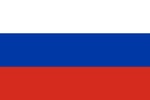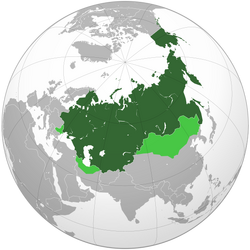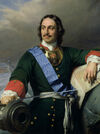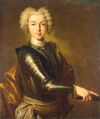
|
The following Cromwell the Great page or section is a proposal.
It has not been ratified and is therefore not currently part of the Cromwell the Great timeline. You are welcome to correct any errors and/or comment on the talk page. If you add this template to an article, please don't forget to mention this proposal on the main discussion page. |
| Russian Empire Россійская Имперія Timeline: Cromwell the Great
(Rossiyskaya Imperiya) OTL equivalent: Russian Empire (1721–1917) | |||||
|---|---|---|---|---|---|
|
|||||
| Motto: S nami Bog! / Съ нами Богъ! (Russian: God is with us!) |
|||||
| Royal anthem: Bozhe, Tsarya khrani! Божѣ, Царя храні! (God Save the Tsar!) |
|||||
| Capital (and largest city) | Saint Petersburg | ||||
| Other cities | Moscow, Yekaterinburg, Kazan and Nizhny Novgorod | ||||
| Official languages | Russian | ||||
| Regional languages | German, Polish (recognized) | ||||
| Other languages | Armenian, Azerbaijani, Belorussian, Chechen, Circassian, English, Estonian, Farsi, Finnish, Georgian, Kazakh, Kyrgyz, Latvian, Lithuanian, Mongolian, Romanian, Swedish, Tajik, Tatar, Turkish, Turkmen, Ukrainian and Uzbek | ||||
| Religion | Orthodox Christianity (official)
Roman Catholicism, Protestantism, Lutheranism, Judaism, Islam and Buddhism |
||||
| Demonym | Russian | ||||
| Government | Absolute monarchy (1721–1825), Autocratic constitutional monarchy (1825 to date) | ||||
| - | Emperor | Alexander II (Holstein-Gottorp-Romanov) | |||
| - | Chairman of the Committee of Ministers | Alexey Fyodorovich Orlov | |||
| Legislature | Emperor along with the legislative assembly | ||||
| - | Upper house | State Council | |||
| - | Lower house | State Duma | |||
| Establishment | |||||
| - | Empire proclaimed | 1721 | |||
| Currency | Russian ruble (1p = 100 kopeks) | ||||
| Time zone | UTC +2 to +4 | ||||
| Date formats | dd/mm/yyyy (AD) | ||||
| Drives on the | right | ||||
| Membership international or regional organizations | Congress System (member) | ||||
Пространное государство предполагает самодержавную власть в той особе, которая оным правит. Надлежит, чтобы скорость в решении дел, из дальних стран присылаемых, награждала медление, отдаленностию мест причиняемое. Всякое другое правление не только было бы России вредно, но и вконец разорительно.[1]
(Nakaz of Catherine II the Great)
The Russian Empire (Russian: Российская Империя, tr. Rossiyskaya Imperiya)[2] is an empire that exists across Eurasia and North America from 1721, following the end of the Great Northern War.
History[]
The third largest empire in world history, stretching over three continents. The rise of the Russian Empire happened in association with the decline of neighboring rival powers: the Swedish Empire, the Commonwealth of Three Nations, Persia and the Ottoman Empire. Under Catherine III the Great, Russia gained access to the Black Sea after gaining Crimea from the Ottoman Empire. It played a major role in European Revolutionary Wars (1790-1810) in defeating French ambitions to control Europe and later Russia expanded to the west and south of Eurasia.
The Legacy of Peter the Great[]
Times of Changes[]

Former flag of the Russian Empire until 1803. Also the flag of republican parties and groups of the Empire and the Russian Federation.
Although, Russia came out triumphant after the Peace of Vienna (1810) in formalizing its Central and Eastern European interests, internal dissent to autocratic rule grew in size and uncontrolled in wide sectors of society.
The European Revolutionary Wars revealed the inefficiencies of its Army and government and its economic and social backwardness with the rest of Europe. Being Russia one of the last Enlightened absolutist monarchies reforms were enacted from above and applied by state bureaucracy and the Army. Isolation, autocracy and censorship became the chief policies along gradual economic and military modernization.
The New Ideas (Новые идеи trans. Novyye idei) movement emerged as the solution for the social, political and economical backwardness of Russia. This movement was highly influential in the intelligentsia, part of the mercantile class and aristocracy, miliary circles and parts of the Imperial bureaucracy. However it proved to be too revolutionary for the autocratic czar and conservative aristocracy, for advocating democracy, liberalism and constitutionalism. Its promoters were stamped out and exiled to Siberia.
The Slavophile movement (Славянофильское движение) opposed the liberal and Western influences of the New Ideas. Slavophiles instead believed in the unique Russian traditions and culture and the Orthodox religion, that they sought to protect from Western individualism. They praised rural life the protection of rural communities (mir) in opposition to industrialization and modern urban life.
The Age of Reforms under Constantine I[]
The death of Emperor Alexander I (1825) unleashed the already uneasy truce between reformers and reactionaries in the Imperial Court and State. Republican secret societies saw a change to state a military coup and proclaim a republic, that was ill fated as the coup was crushed before it it even began and its ringleaders executed. However nobody foresaw that dynastic struggle between Alexander I's brothers for the imperial crown leading to the Civil War of 1825.
The Civil War of 1825 between Constantine's Constitutionalists (Decembrist), Nicholas' Court Party (Reactionaries) gave the victory to the first. Under Constantine I a slow but a firm establishment of autocratic constitutional rule began. The centralized nature of rule as kept but guberniyas (governorates) were given some sort of autonomy. Local government under elected zemstvo (local councils) were established. an advisory body of the Emperor, the State Duma, was established with half of its deputies elected by electoral assemblies, the other half named by the Czar on lists of proposed candidates draw up by the State Council.
However, no law can be made without the Duma's assent, neither can the Duma pass laws without the approval of the noble-dominated upper chamber, the State Council (half of which is appointed directly by the Emperor), and the Emperor himself retaining an absolute veto. The constitution and laws stipulate that ministers can not be appointed by, and are not responsible, to the Duma.
The Supreme Privy Council remained the main body of advisors to the Emperors, tough an executive body was established, the Committee of Ministers. The Committee's chairperson the de facto chief of government, carrying out daily the administration of the state and order of the Emperor. The chairman and ministers are named by the Emperor.
However, the autocratic unlimited powers of the Emperors and Empresses are limited by two constraints: they and their spouses must profess the Russian Orthodox faith, and they must obey the laws of succession laid down by Emperor Paul I as modified by Constantine I.
Emperor Constantine I enacted several reforms: reorganization the judicial system, setting up elected local judges, abolishment of corporal punishment, promotion of local self-government through the zemstvo system, imposition of universal military service, ending some privileges of the nobility, and promotion of university education.
The Early Russian Industrial development began under the auspices of Constantine I by means of state railroad and public works concessions and promote industry in Western Russia and the Volga and the mining concessions in Siberia.
Constantine I's resolution to dismember the Commonwealth of the Triple Nations occupied most of his mind in foreign affairs after the Aegean Crisis (1827-1833).
The Great Eastern War and the defeat and dissolution of the Polish–Lithuanian-Ruthenian Commonwealth enable for Russia to gain several allied states such as Belarus, Ruthenia and Lithuania. Poland was limited in its influence.
Consolidation[]
In 1856, Alexander II abolished serfdom, and consolidated Constantine I's industrial development.
Emperor of All Russia[]
Chairperson of the Committee of Ministers[]
Administrative Divisions[]
The Russian Empire is divided in governorates (guberniya), ruled by a governor. Governorates are further subdivided into oblast, uezd and volost. The Governor-Generalship are territories that consisted of set of guberniyas and oblasts. These are the Governor-Generalship of the Steppes, Caucasus, Turkestan, Siberia, Irkutsk, Far East and Alaska. The Primorskaya Oblast as a special status within the Far East Governor-Generalship.
Protectorates of Russia are the Bukey Horde and the Khanate of Khiva.
| |||||||||||||||||||||||
- ↑ A vast state presupposes autocratic power in the person who rules it. It is necessary that the speed in solving cases sent from distant countries reward the slowness caused by the remoteness of places. Any other government would not only be harmful to Russia, but completely ruinous.
- ↑ or simply Russia (Russian: Россия, tr. Rossiya)



















